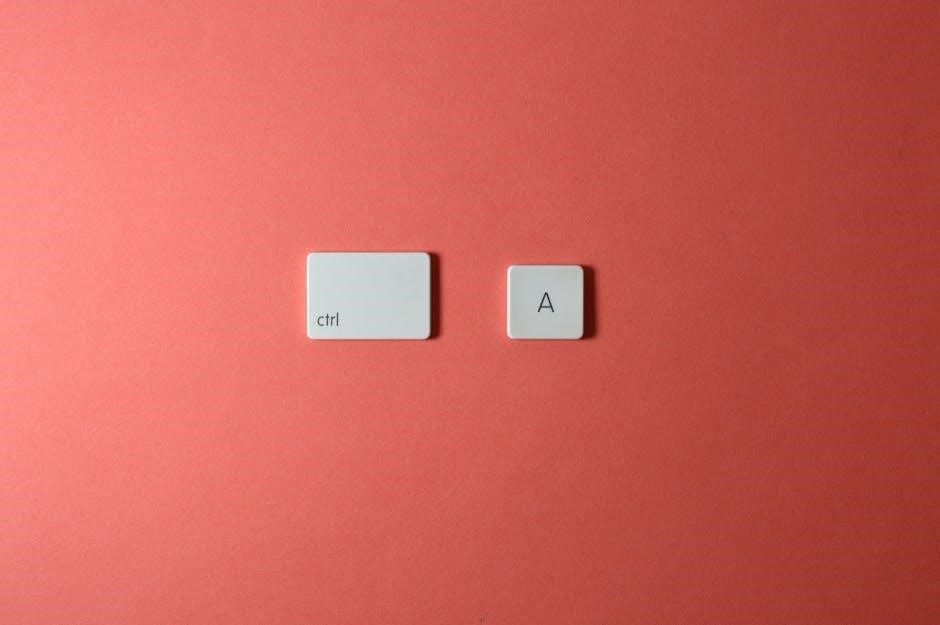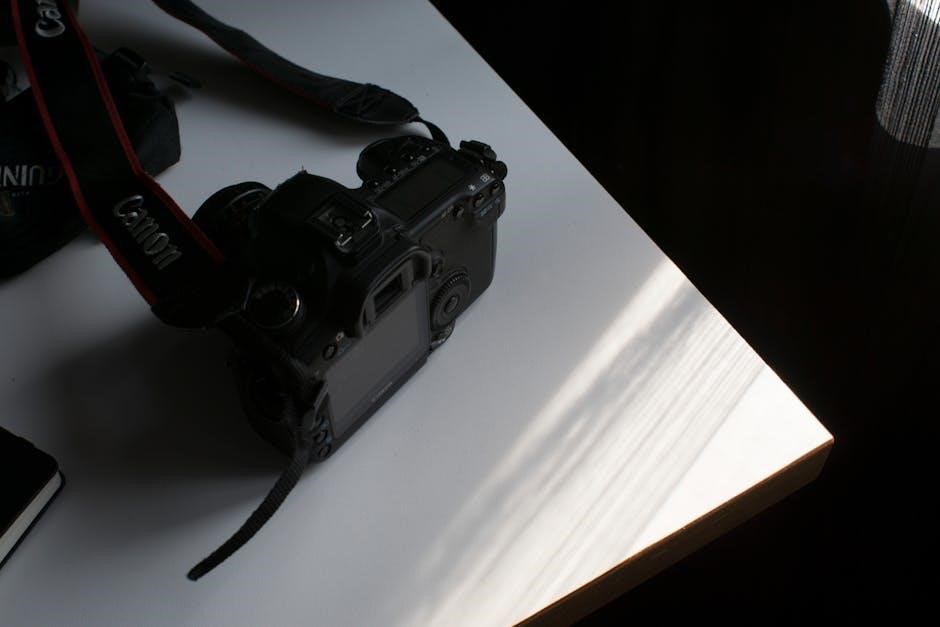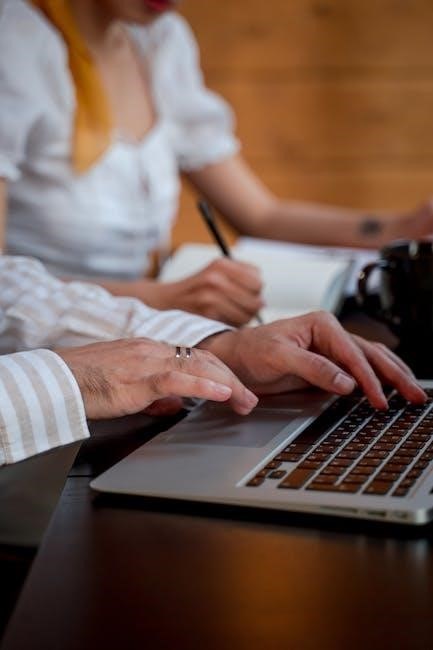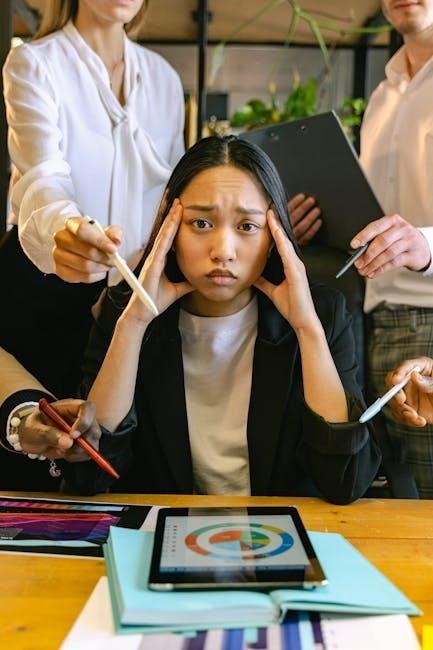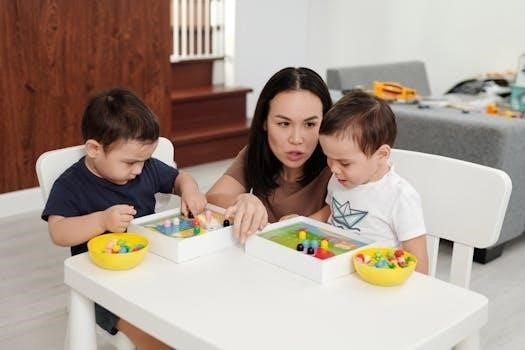Properly using a harness lead ensures comfort and control for both dogs and owners. Durable materials like nylon or leather provide strength, while correct fitting prevents discomfort. Training and patience help dogs adapt to wearing a harness, making walks enjoyable and stress-free for everyone involved.
1.1 What is a Harness Lead?
A harness lead is a device designed to guide and control a dog during walks, consisting of a vest-like harness and a leash. It distributes force across the dog’s chest and shoulders, reducing neck strain. Unlike collars, harnesses are gentler and provide better control, especially for strong or energetic dogs. They often feature adjustable straps for a secure fit and come in various styles, such as standard, no-pull, or puppy-specific designs. Harness leads are popular for their comfort, effectiveness, and versatility in training and everyday use.
1.2 Importance of Proper Harness Use
Proper harness use is essential for ensuring your dog’s comfort and safety. A well-fitted harness distributes force evenly, reducing the risk of neck injuries and discomfort. It also provides better control, making walks more enjoyable for both you and your dog. Correct use prevents the harness from slipping or causing irritation. Additionally, proper harness use aids in training, helping dogs learn to walk calmly without pulling. By following guidelines, you can enhance your dog’s walking experience and strengthen your bond during outings.
1.3 Brief History of Dog Harnesses
Dog harnesses have evolved significantly over time, with early versions used for working dogs like sled pullers and carts. The concept dates back to ancient civilizations, where dogs were harnessed for labor. In the mid-20th century, harnesses became popular for pet dogs, offering an alternative to collars. Modern designs focus on comfort, safety, and functionality, with variations like no-pull harnesses emerging. Today, harnesses are a staple in dog ownership, promoting enjoyable walks and effective training. Their history reflects a shift from utility to a balance of practicality and pet well-being.
Types of Dog Harnesses
Dog harnesses come in various styles, including standard, no-pull, and puppy-specific designs. Each type serves different purposes, ensuring comfort, control, and durability for dogs of all sizes and needs.
2.1 Standard Dog Harness
A standard dog harness is a versatile option designed for everyday use. It typically features a simple design with adjustable straps to ensure a comfortable fit. Made from durable materials like nylon or leather, it distributes the force across the dog’s chest, reducing strain on the neck. This harness is suitable for dogs of all sizes and is ideal for casual walks. Proper fitting is essential to prevent discomfort and ensure effective control during walks. Regular use helps dogs adapt to wearing it, making outings enjoyable for both the dog and owner.
2.2 No-Pull Harness
A no-pull harness is specifically designed to help dogs that tend to pull on the lead. It works by redistributing the force of the pull across the dog’s chest and shoulders, discouraging pulling behavior. This type of harness is an effective training tool, helping owners maintain better control during walks. It is not a replacement for proper training but serves as an aid to make walking more manageable. The no-pull harness is ideal for strong or energetic dogs, promoting a more enjoyable walking experience for both the dog and the owner.
2.3 Puppy-Specific Harness
A puppy-specific harness is designed for young dogs, ensuring comfort and safety during their growth phase. These harnesses are typically made from soft, breathable materials to prevent irritation. They often feature adjustable straps to accommodate growing puppies. Introducing a harness early helps puppies get used to wearing one, making future walks easier. Positive reinforcement, such as treats, can help puppies associate the harness with positive experiences. Proper sizing is crucial to avoid restricting movement or causing discomfort. A well-fitted puppy harness promotes healthy development and sets the foundation for enjoyable walks as they grow into adult dogs.
Benefits of Using a Harness
Using a harness provides comfort, better control, and reduces neck injury risks for dogs. It promotes positive walking experiences, especially for puppies, and is a safer alternative to collars.
3.1 Comfort for Dogs
A well-fitted harness ensures optimal comfort for dogs by reducing neck strain and distributing pressure evenly across the chest and shoulders. This design prevents discomfort during walks, especially for puppies or dogs with neck sensitivity. Harnesses made from soft, breathable materials further enhance comfort, while adjustable straps allow for a customized fit. Introducing the harness gradually, with positive reinforcement, helps dogs associate it with positive experiences. This approach minimizes stress and makes wearing the harness a pleasant experience for your pet.
3.2 Better Control for Owners
A harness provides owners with better control over their dogs, especially during walks. The design distributes pressure across the chest and shoulders, reducing pulling behavior. This makes it easier to guide the dog without causing discomfort. Features like adjustable straps and secure clips ensure a stable fit, allowing owners to manage their dog’s movements effectively. Proper fitting is crucial to maintain control while ensuring the dog’s comfort. Durable materials and sturdy construction further enhance reliability, making harnesses a practical choice for owners seeking to manage their pets confidently and safely.
3.4 Reduced Risk of Neck Injury
Harnesses significantly reduce the risk of neck injury compared to traditional collars. By distributing force across the chest and shoulders, harnesses prevent strain on the delicate neck area. This is especially beneficial for dogs that pull or lunge, as it minimizes the likelihood of neck sprains or injuries. Dogs with pre-existing neck conditions or respiratory issues also benefit from the added protection a harness provides. Properly fitted harnesses ensure comfort and safety, making them a superior choice for dogs of all sizes and breeds.
Choosing the Right Harness
Selecting the right harness involves measuring your dog accurately, considering durable materials, and ensuring adjustability for a comfortable fit. Proper fit prevents discomfort and ensures safety.
4.1 Measuring Your Dog
Accurate measurement is crucial for a proper fit. Measure your dog’s girth around the deepest part of their chest, just behind the front legs. Ensure the harness isn’t too tight or loose, allowing two fingers to fit comfortably between the harness and your dog’s skin. Adjust straps carefully to avoid restricting movement. For puppies, consider growth potential when choosing a size. Proper measurement ensures comfort and prevents chafing, making walks enjoyable for your dog. Always refer to size charts and adjust as needed for the best fit.
4.2 Materials and Durability
Choosing a harness made from durable materials ensures longevity and comfort. Nylon, leather, and fabric webbing are popular options, offering strength and resistance to wear. Look for reinforced stitching and sturdy hardware, such as metal buckles, to withstand regular use. Breathable materials help prevent skin irritation, while padded sections enhance comfort. Durable harnesses are less likely to slip or break, providing reliable control during walks. Investing in high-quality materials ensures your dog’s harness remains functional and comfortable over time, making it a worthwhile investment for daily use.
4.3 Adjustability Features
Adjustability is crucial for a proper fit, ensuring comfort and control. Look for harnesses with multiple adjustment points, such as chest and girth straps, to accommodate your dog’s unique shape. Padded chest plates and soft lining reduce friction and prevent chafing. Adjustable features allow the harness to grow with your dog, especially for puppies. Proper adjustment ensures the harness doesn’t restrict movement or cause discomfort. Easy-to-use buckles and straps make fitting straightforward, while reinforced stitching ensures durability. A well-adjusted harness promotes a stress-free walking experience, adapting to your dog’s needs and providing long-term comfort and support.
Putting on a Harness
Introduce the harness calmly, letting your dog investigate it with treats. Slip it over their head gently, ensuring proper fit without restricting movement for a stress-free experience.
5.1 Step-by-Step Guide
Place the harness on the floor with treats to help your dog associate it positively. 2. Gently slip the harness over your dog’s head, ensuring proper alignment. 3. Adjust the straps to fit snugly without restricting movement. 4. Reward calm behavior to reinforce a positive experience. For reluctant dogs, start with short sessions and gradual introduction. This method ensures a stress-free and effective harness fitting process.
5.2 Tips for Reluctant Dogs
For dogs hesitant to wear a harness, start with positive reinforcement. Place the harness on the floor with treats to encourage exploration. Gradually introduce it by letting your dog sniff and investigate at their own pace. Avoid forcing it on, as this can create negative associations. Use desensitization techniques, such as offering treats while showing the harness. Begin with short sessions, allowing your dog to become comfortable before attempting to put it on. Consistency and patience are key to helping reluctant dogs accept the harness.
Introducing a harness to your dog should be a calm and positive experience. Start by placing the harness on the floor with treats scattered around it, allowing your dog to explore at their own pace. Let them sniff and investigate without pressure. Once they show interest, gently place the harness on their back, rewarding them with treats and praise. Avoid forcing it on, as this can create anxiety. Gradually increase exposure, ensuring your dog associates the harness with positive outcomes. Patience and consistency are key to a stress-free introduction.
Training with a Harness
Training with a harness involves positive reinforcement, clear commands, and consistent practice. Start with short sessions, rewarding good behavior to build trust and confidence in wearing the harness.
6.1 Basic Leash Training
Start by introducing the harness gradually, letting your dog explore it at their own pace. Reward calm behavior with treats to build positive associations. For the first walk, keep the leash slack and allow your dog to set the pace. Use verbal cues like “walk” or “heel” to guide them. Avoid pulling back on the leash, as this can create resistance. Instead, stop and wait for your dog to focus on you before continuing. Consistency and patience are key to helping your dog learn to walk comfortably on a leash with their harness.
6.2 Advanced Commands
Once your dog is comfortable with basic leash walking, introduce advanced commands like “heel” and “stop.” Use verbal cues and hand signals to reinforce these commands. Practice turning corners and changing pace to improve your dog’s responsiveness. Incorporate distractions like other dogs or people to test their focus. Reward your dog with treats and praise when they perform commands correctly. Consistency is key to helping your dog master these advanced techniques, ensuring a more enjoyable and controlled walking experience for both you and your dog.
6.3 Positive Reinforcement Techniques
Positive reinforcement is a powerful tool for training your dog with a harness. Reward desired behaviors like walking calmly or responding to commands with treats, praise, or play. Use clicker training to mark good behavior instantly. Start by associating the harness with treats, letting your dog explore it at their own pace. Gradually introduce leash walking, rewarding calmness. Avoid pulling back on the leash, as this can create resistance. Instead, stop and wait for your dog to focus before continuing. Consistency and patience will help your dog associate the harness with positive experiences, making training more effective and enjoyable for both of you.
Troubleshooting Common Issues
Address common problems like pulling, slipping, or resistance by ensuring proper fit, using positive reinforcement, and consistent training. Patience and adjustments can resolve most challenges effectively.
7.1 Dog Pulling on the Lead
Dogs often pull on the lead due to excitement, curiosity, or lack of training. To address this, ensure the harness fits properly and use positive reinforcement techniques. Stop walking when your dog pulls, encouraging them to return to your side before continuing. Consistent training and patience are key. Reward calm behavior and consider using a no-pull harness designed to redistribute force. Over time, your dog will learn to walk beside you without pulling, making walks more enjoyable for both of you.
7.2 Harness Slipping Off
A harness may slip off if it’s improperly fitted or adjusted. Ensure the harness is snug but not too tight, with adjustable straps securing it around your dog’s chest and shoulders. Regularly check the fit, especially for growing puppies. Use a double-back buckle for added security and consider a harness with additional fasteners for better stability. If the harness still slips, try a different style or size. Proper fitting and regular adjustments will prevent the harness from shifting during walks, keeping your dog safe and secure.
7.3 Dog Resistance to Wearing Harness
Some dogs may resist wearing a harness due to discomfort, unfamiliarity, or negative associations. Introduce the harness gradually by placing it on the floor with treats to create a positive connection. Allow your dog to explore it at their own pace. Start with short sessions, rewarding calm behavior. Avoid forcing the harness on, as this can worsen resistance. Use positive reinforcement, such as treats and praise, when your dog tolerates the harness. Gradually increase exposure, ensuring your dog feels safe and comfortable. Patience and consistency are key to overcoming resistance and making the harness a positive experience.
Maintenance and Care
Regularly clean your dog’s harness with mild soap and water to prevent dirt buildup. Avoid harsh chemicals and ensure it dries thoroughly to maintain durability and comfort.
8.1 Cleaning the Harness
Cleaning your dog’s harness is essential for maintaining hygiene and durability. Use mild soap and warm water, gently scrubbing away dirt and odors. Avoid harsh chemicals or abrasive cleaners, as they can damage materials. Rinse thoroughly to remove all soap residue. Allow the harness to air dry completely to prevent mold or mildew. Regular cleaning ensures your dog stays comfortable and the harness remains in good condition for extended use. Additionally, placing treats on the harness can help your dog associate it with positive experiences, making it easier to put on during walks.
8.2 Storage Tips
Proper storage of your dog’s harness ensures it remains in excellent condition. After cleaning, allow the harness to air dry completely before storing it in a cool, dry place. Avoid direct sunlight, as it can cause fading or material degradation. Store the harness away from pets or children to prevent accidental damage. Consider hanging it or placing it in a breathable bag to maintain its shape. Regularly inspect the harness for wear and tear before reuse. Proper storage extends the lifespan of the harness, ensuring it remains comfortable and functional for your dog.
8.3 When to Replace the Harness
Replace your dog’s harness when it shows signs of wear, such as fraying, cracks, or weakened stitching. If the material becomes brittle or loses its shape, it’s time for a new one. Check metal hardware for rust or damage, as this can compromise safety. If the harness no longer fits properly or causes discomfort, replace it to ensure your dog’s well-being. Regular inspections help identify when a replacement is needed, ensuring your dog remains safe and comfortable during walks and activities.
Accessories for Harness Leads
Enhance your dog’s harness with practical accessories like reflective strips for visibility, durable leash attachments, and customizable ID tags. These additions improve safety and functionality during walks.
9.1 Leash Attachments
Leash attachments are essential for securing your dog’s harness to the lead. Durable materials like nylon or leather ensure strength and longevity. Choose from carabiners, clips, or snap hooks for easy use. Reflective attachments enhance visibility, while padded handles provide comfort for owners. Adjustable straps allow customization to fit your dog’s size and walking style. Properly fitted attachments prevent slipping and ensure a secure connection. Regularly inspect for wear and tear to maintain safety. The right leash attachment enhances both control and comfort, making walks more enjoyable for you and your dog.
9.2 ID Tags and Patches
ID tags and patches are practical accessories for harness leads, ensuring your dog’s identification is clear. Made from durable materials like nylon or leather, they withstand regular use. Reflective patches enhance visibility, especially during evening walks. Customizable options allow you to add your dog’s name or your contact information. Patches can also denote medical conditions or specific needs. Easy to attach, they provide peace of mind and style. Choose from various designs and colors to match your dog’s harness. These accessories are both functional and fashionable, making them a great addition to your dog’s walking gear.
9.3 Reflective Strips for Visibility
Reflective strips on harness leads enhance visibility, ensuring your dog is seen in low-light conditions. Placed strategically on the harness, they reflect light from car headlights or streetlights. Made from durable materials like nylon or fabric webbing, these strips withstand regular use. They are especially useful for evening or early morning walks. Reflective strips not only improve safety but also add a stylish touch to the harness. They can be paired with other accessories like ID tags or patches for added functionality. This feature is a must for owners who prioritize their dog’s safety and visibility during walks.
Conclusion
Proper harness lead use ensures safety, comfort, and control for both dogs and owners. Regular training, durable materials, and visibility accessories like reflective strips make walks enjoyable and stress-free.
10.1 Summary of Key Points
Proper harness lead use ensures comfort, control, and safety for dogs and owners. Durable materials like nylon or leather provide strength, while correct fitting prevents discomfort. Training and patience help dogs adapt to wearing a harness, making walks enjoyable. Accessories like reflective strips enhance visibility, and regular maintenance ensures longevity. Positive reinforcement techniques and stress-free introduction methods are key for reluctant dogs. Understanding different harness types, such as standard or no-pull, helps in choosing the right one for your dog’s needs. Consistent training and proper care ensure a hassle-free walking experience for both you and your pet.
10.2 Final Tips for Harness Use
Always ensure a proper fit to avoid discomfort or restriction. Introduce the harness gradually, using positive reinforcement to build your dog’s confidence. Choose durable materials and necessary accessories like reflective strips for safety. Regularly inspect and clean the harness to maintain its condition. For reluctant dogs, start with short sessions and reward calm behavior. Consistent training and patience are key to a stress-free walking experience. By following these tips, you can maximize the benefits of using a harness and enjoy a more enjoyable and controlled walk with your dog.
